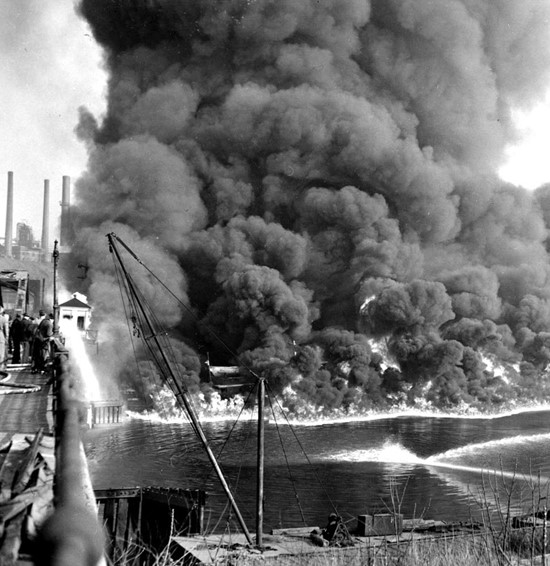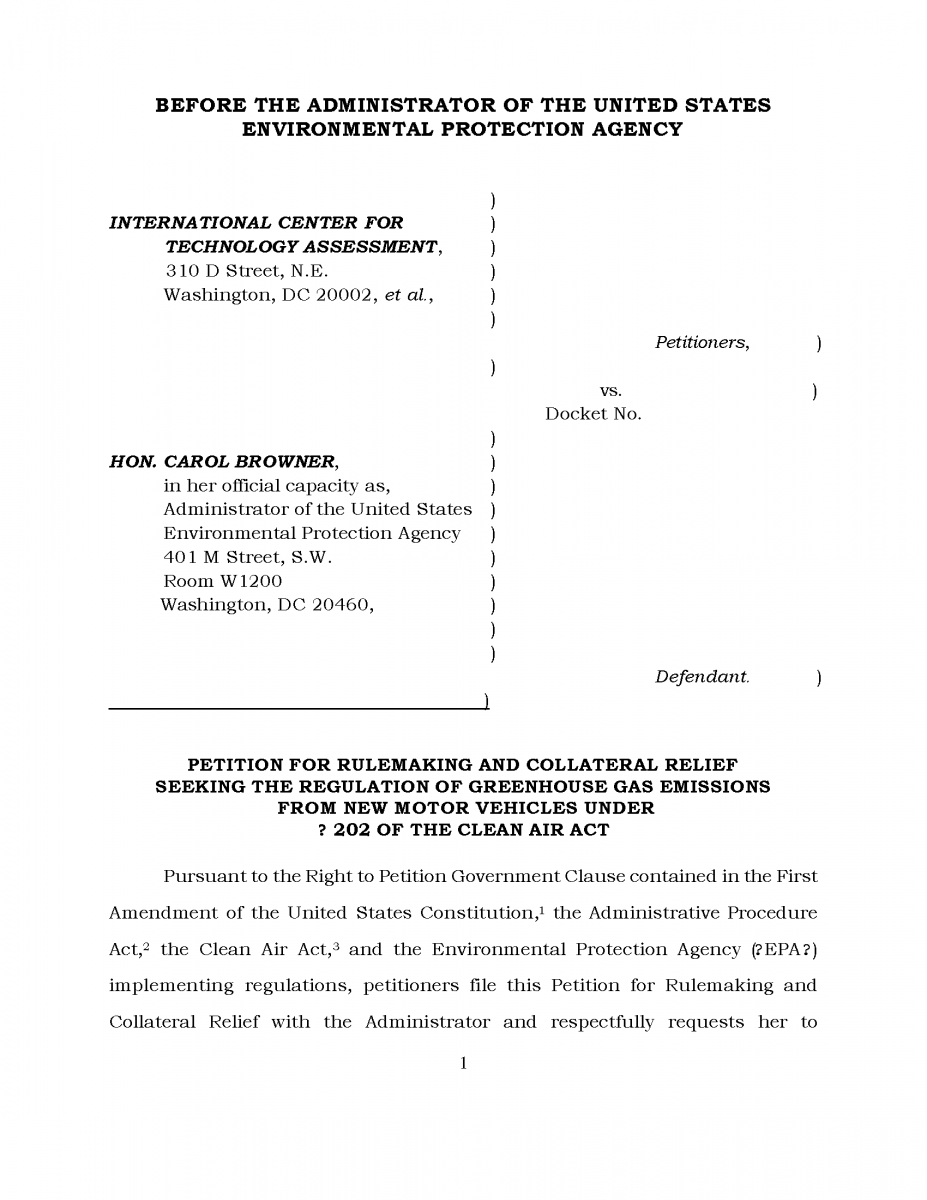Any self-respecting environmental lawyer knows, 2019 marks a major anniversary for environmental law: the Cuyahoga River fire of 1969. While we note the anniversary today, I doubt onlookers in Cleveland appreciated at the time that it would give rise to a five-decade era of environmental lawmaking.

The memorable start of the environmental law movement is engrained in our minds with historic photos of the 1969 Cuyahoga River Fire.

The start of climate change law is perhaps less vivid, but just as impactful.
2019 also marks another significant anniversary a bit less prominent than Cuyahoga. Twenty years ago, in 1999, the International Center for Technology Assessment (ICTA) filed a petition asking EPA to adopt a then-novel theory: transform the Clean Air Act as the first legal tool to address climate change.
Granted, the 43-page, single-spaced, 140-footnote ICTA petition doesn’t have the same visual flare as a river on fire. But in terms of influence of environmental law, I think it’s just as important. That’s because the ICTA petition marks the beginning of climate change law, making 2019 the 20th anniversary.
The ICTA filing gave rise to the most important opinion on climate change, the U.S. Supreme Court’s Massachusetts v. EPA decision, eight years later.And, a decade after that, Massachusetts, in turn, has reached much further. The decision can be more broadly appreciated as endorsing climate change as a mainstream issue, leading to the first greenhouse gas controls domestically, providing a model for other nations and sub-national governments to act, and, four decades after Cuyahoga, ushering a second generation of environmental law.
Despite those accomplishments, the 2007 Massachusetts decision also represents the apex of climate change law so far. Initially, in the years following Massachusetts, as EPA worked to enact the first greenhouse gas regulations for cars, I believed the law had earned more credit for greenhouse gas reductions than science, policy, or technology because of enforceable regulations on the books.
But today, I doubt whether the law is still playing that lead role. Right now, science is driving the urgency of climate change and technology is doing the most to achieve actual reductions. Policy remains far unsettled but is trending again as a focus of attention to unlock solutions.
In contrast, for the last five years or so, the law has been stuck in a holding pattern. But if we look ahead to the next 20 years of climate change law, the elements of a more vigorous legal framework of the future are already setting the stage.
- International: Climate change is a global issue, and one of the most impactful legal developments post-Massachusetts is groups around the world bringing analogous cases on their home turf. Perhaps, the most well-known is the Urgenda decision in the Netherlands, which went further than Massachusetts and set actual greenhouse gas reduction targets for the government. But in my research, almost every international court to consider a Massachusetts-type claim, where a group asks a court to assess the legal basis for the government to address climate change, has ruled for the petitioners. These decisions, in upcoming years, will lead to an expanded framework of greenhouse gas regulations globally.
- Subnational governments: States, provinces, and cities have done the most legally interesting things. In many instances, these entities have the benefit of organic laws that can empower them to act with less legal scrutiny than current federal laws. In other instances, these initiatives present law school exam-worthy questions about preemption, displacement, and conflicts with federal laws and even the U.S. Constitution. Regardless, the momentum here is picking up the fastest and offers a test bed for a diverse menu of climate change legal solutions—but also the challenge of a potentially inefficient patchwork quilt of regulations in attempting to solve an issue that’s inherently global.
- Federal regulation: The main act of the first decades of climate change law has been testing the limits of the Clean Air Act. Some have proven successful—a concrete determination that greenhouse gases endanger the environment and enforceable greenhouse gas reductions from mobile sources. Some have proven elusive—the Clean Power Plan’s well-intentioned but legally flawed attempt to regulate energy over emissions, and the square peg/round hole conundrum of using the Clean Air Act to address scores of other sectors. Ultimately, until Congress acts, Clean Air Act regulations will gradually fill in the limits of the Act’s legal authority to the extent consistent with the Act’s considerations of technology and cost/benefit analysis. At the same time, it’s undeniable that this statute, even at those limits, will not provide the holistic solution necessary.
- Federal legislation: If you surveyed 100 climate change lawyers on the biggest frustration in climate change law, the answer undeniably would be Congress’ failure to act. The absence of the necessary legal tools has delayed needed action and in the void has created a ping-pong match of regulatory uncertainty through numerous legal squabbles. The future of climate change law needs actual law at the foundation. While the proposed comprehensive approaches are theoretically appealing in that they would provide the needed holistic solution, they may be realistically out of reach in the near term. A new pragmatic approach may be warranted, one where Congress creates the building blocks for a comprehensive program one-by-one, which, like a Lego set, ultimately lock together to provide an integrated solution over time.
- Climate change litigation: Of all these categories, climate change litigation gets the headline attention, which may be fair given climate change law itself is the product of litigation that led up to the Massachusetts decision. Litigation will continue to have an important role to play internationally in reviewing government’s authority to take action under existing laws, such as the Massachusetts/Urgenda type decisions, and domestically in cases that test the limits of authority under existing laws. At the same time, the line of litigation invoking various legal theories—some centuries old—to pursue companies for historic greenhouse gas emissions suffers fatal legal flaws, and is a distraction from marshalling resources to develop an actual approach. It would be better for these parties to work toward a policy solution that can be implemented and enforced in law rather than engaging in highly adversarial litigation that will distract from constructive approaches and make collaboration harder for years to come.
- The role of lawyers: Of course, climate change law cannot progress without the contribution of lawyers, and it’s perhaps most encouraging to see so many initiatives advancing. Having played an integral role in the development of environmental law and policy for 50 years, ELI has been front and center. For example, it drafted a Model Law Implementing the Nationally Determined Contributions Submitted Under the Paris Agreement to support the progress of those countries who are serious about meeting their Paris goals via a national-level, climate change law. And its book division, ELI Press, has released a number of books on the topic, including Legal Pathways to Deep Decarbonization in the United States and Contemporary Issues in Climate Change Law and Policy: Essays Inspired by the IPCC. The American Bar Association approved a resolution in 2008 urging Congress to act, and is considering a broader revision in 2019. And I’m proud of the International Bar Association’s work assessing climate change under a human rights lens, including a 2016 report and an upcoming model statute. With all this, I think our biggest challenge as lawyers may not be developing new ideas or solutions, but streamlining and distilling all these existing ideas in ways that can be readily understood and implemented in a pragmatic matter by diverse audiences, while reflecting law, science, technology, and policy.
For those of us who have been around for much of these 20 years (for the record, I was the EPA counsel of record that lost Massachusetts in 2007), it’s hard to fathom we’re already two decades into these issues. For an environmental lawyer, they’ve truly been among the most important and challenging legal issues of a generation, shaped by some of the most passionate and creative legal minds on all sides (present company excluded). What’s most certain about the future is that the pace, complexity, and intensity of these legal questions are going to accelerate now that the foundation has been set. And I’m confident that, as with the environmental law framework that followed what, at the time, seemed like an insurmountable issue in Cuyahoga, the law will rise with science, technology, and policy to play its part in an effective solution.
*The views, thoughts, and opinions expressed in this blog belong solely to the author, and not necessarily to the author’s employer, organization, committee or other group or individual.